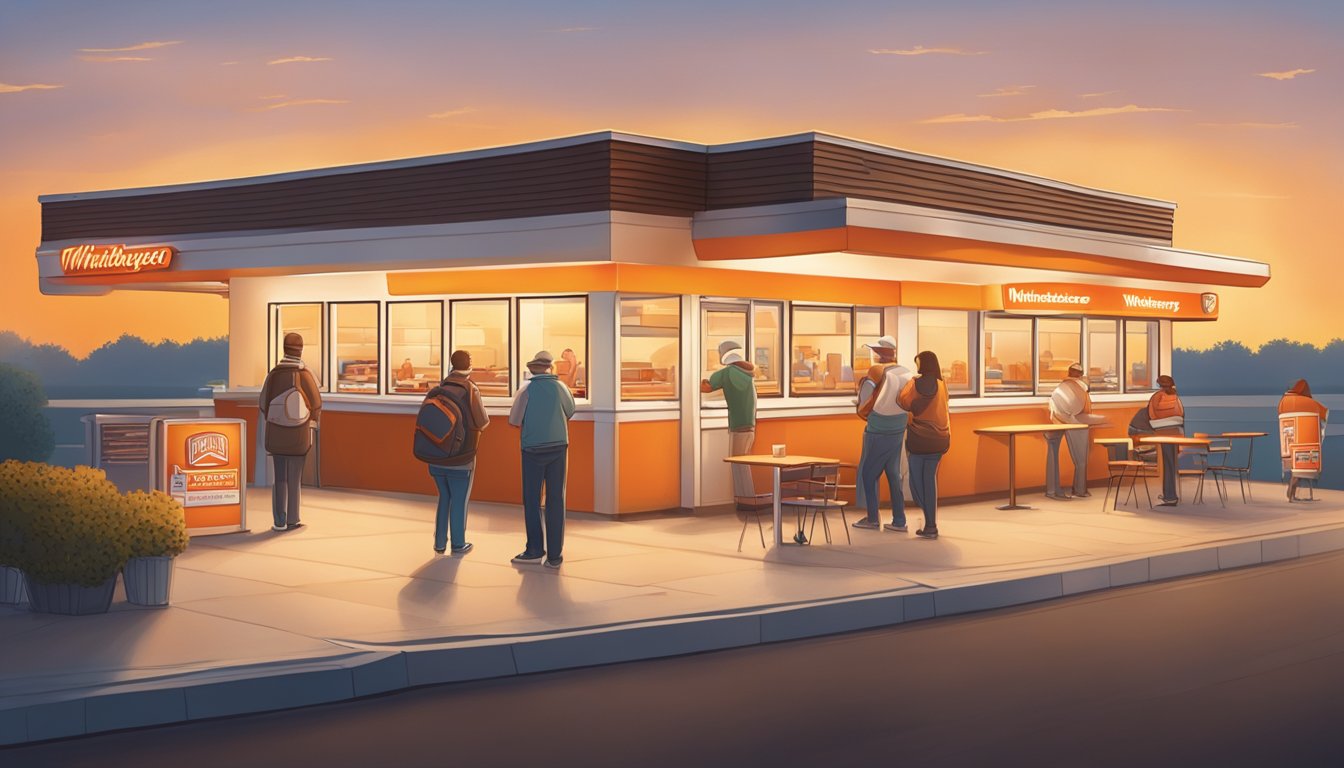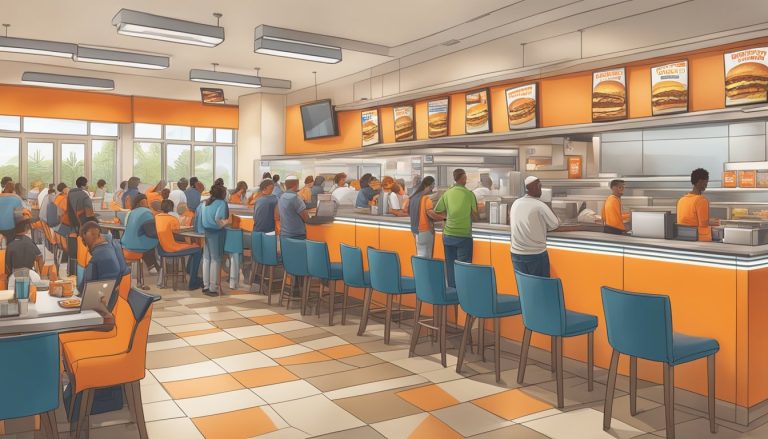Whataburger’s breakfast marketing strategy taps into the psychological drivers that influence consumer behavior in the early hours. The fast-food chain recognizes the importance of morning routines and caters to both early risers and night owls with its extended breakfast hours from 11 p.m. to 11 a.m. This approach leverages the psychological principle of convenience, making Whataburger a go-to option for those seeking a quick and satisfying meal at unconventional times.
The company’s emphasis on quality and customization in its breakfast offerings appeals to customers’ desire for choice and personalization. By allowing patrons to tailor their breakfast sandwiches and offering a diverse menu that includes taquitos, pancakes, and biscuit sandwiches, Whataburger taps into the psychological need for autonomy and self-expression in food choices.
Whataburger’s marketing also capitalizes on the emotional connection many people have with breakfast foods. The comfort and nostalgia associated with classic breakfast items are powerful motivators that the chain harnesses to create a strong brand identity. This emotional appeal, combined with consistent quality and service, fosters customer loyalty and repeat business in the competitive fast-food breakfast market.
The Legacy of Whataburger
Whataburger’s enduring legacy stems from its humble beginnings as a small burger stand to its current status as an iconic fast-food chain. The company’s growth and expansion are rooted in its founder’s vision and family leadership.
Founder Harmon Dobson and His Vision
Harmon Dobson established Whataburger in 1950 in Corpus Christi, Texas. His goal was to create a burger so big that customers would exclaim “What a burger!” when they saw it.
Dobson’s vision centered on quality, freshness, and made-to-order food. He insisted on using 100% pure beef patties and larger-than-average 5-inch buns.
This commitment to quality and size set Whataburger apart from competitors. Dobson’s innovative approach laid the foundation for the chain’s future success.
From Burger Stand to Iconic Chain
Whataburger’s growth from a single stand to a beloved chain was steady and deliberate. The company expanded across Texas in its early years.
By the 1960s, Whataburger had become a recognizable brand in the Southern United States. Its orange-and-white striped buildings became landmarks in many communities.
The chain’s 24/7 service, introduced in the 1980s, further cemented its place in Texas culture. Whataburger now operates 363.5 days a year, closing only for Christmas and half of Christmas Eve.
The Dobson Family and BDT Capital Partners
For 69 years, Whataburger remained a family-owned business. The Dobson family maintained Harmon’s vision and values throughout its expansion.
In 2019, the Dobsons sold their majority stake to BDT Capital Partners. This move aimed to facilitate further growth while preserving the brand’s legacy.
Despite the ownership change, Whataburger has maintained its Texas roots. The company headquarters remains in San Antonio, ensuring its connection to its home state.
Understanding Whataburger’s Customer Base

Whataburger’s success stems from its deep connection with its customer base. The company has built a loyal following through regional identity, customer satisfaction initiatives, and community engagement.
Emotional Connection and Regional Identity
Whataburger’s brand is deeply intertwined with Texas culture and Southern U.S. identity. The company’s orange-and-white striped buildings are iconic landmarks in many communities.
Customers often view Whataburger as more than just a fast-food chain; it’s a symbol of regional pride. This emotional connection is reinforced through menu items that cater to local tastes and traditions.
The brand’s marketing often emphasizes its Texas roots, appealing to customers’ sense of nostalgia and belonging. This strategy has helped Whataburger expand beyond Texas while maintaining its authentic regional appeal.
Customer Satisfaction and Feedback
Whataburger prioritizes customer satisfaction through various feedback channels. The company uses sophisticated tools to assess food quality, service speed, and overall experience.
Customer input directly influences menu development and operational improvements. This approach ensures that Whataburger stays aligned with customer preferences and expectations.
The brand’s social media presence, with millions of followers, serves as a platform for gathering real-time feedback and engaging with customers. Whataburger’s responsive communication style on these platforms strengthens customer relationships.
Community Involvement and Loyalty Programs
Whataburger’s community involvement goes beyond serving food. The company actively participates in local events, sponsors youth sports teams, and supports charitable causes.
These initiatives foster a sense of reciprocal loyalty between the brand and its customers. Many patrons view supporting Whataburger as a way to give back to their community.
The Whataburger loyalty program rewards frequent customers with points and exclusive offers. This program not only incentivizes repeat visits but also provides valuable data on customer preferences and behaviors.
By combining community engagement with targeted rewards, Whataburger creates a multi-faceted approach to building and maintaining customer loyalty.
Branding and Marketing Insights

Whataburger’s branding and marketing strategies have played a crucial role in establishing its strong regional presence and loyal customer base. The company leverages its distinctive identity, innovative campaigns, and digital initiatives to connect with consumers.
Brand Identity and Restaurant Design
Whataburger’s brand identity is deeply rooted in its Texas heritage and regional pride. The iconic orange and white color scheme creates instant recognition. A-frame buildings with their distinctive striped roofs serve as a visual signature for the brand.
The restaurant interiors feature a nostalgic 1950s diner aesthetic, evoking feelings of comfort and familiarity. This design choice reinforces Whataburger’s long-standing history and commitment to tradition.
Menu boards prominently display the company’s slogan “Just like you like it,” emphasizing customization and customer satisfaction. This phrase has become synonymous with the Whataburger experience.
Innovative Marketing Campaigns and Social Media
Whataburger excels at creating engaging marketing campaigns that resonate with its target audience. The company often leverages local events and cultural touchstones to create timely, relevant promotions.
Social media plays a significant role in Whataburger’s marketing strategy. The brand maintains an active presence on platforms like Twitter, Facebook, and Instagram. It uses humor and relatable content to foster a sense of community among fans.
User-generated content is frequently shared, encouraging customers to become brand ambassadors. This approach helps Whataburger maintain an authentic voice and strengthens its connection with consumers.
Digital Marketing and Social Responsibility
Whataburger has embraced digital marketing to reach a broader audience. The company’s mobile app offers convenient ordering and exclusive deals, enhancing customer loyalty.
Email marketing campaigns keep customers informed about new menu items and promotions. Targeted ads on social media platforms help Whataburger reach potential customers in new markets.
Corporate social responsibility initiatives form an integral part of Whataburger’s marketing strategy. The company supports local communities through charitable giving and volunteer programs.
Whataburger’s Feeding Student Success program provides resources to schools and students. This initiative not only benefits communities but also enhances the brand’s reputation as a socially responsible corporation.
Product Strategy and Innovation

Whataburger’s approach to product strategy and innovation focuses on delivering high-quality, customizable menu items that resonate with customers. The company’s commitment to fresh ingredients and local flavors, combined with strategic limited-time offers, keeps their breakfast menu exciting and relevant.
Menu Items and Customization Options
Whataburger’s breakfast menu features a range of made-to-order items that cater to diverse tastes. The iconic Breakfast on a Bun and Taquitos are staples, while newer additions like the Breakfast Burger expand options. Customization is key, allowing customers to modify ingredients to their liking.
Customers can add jalapeños, bacon, or extra cheese to their breakfast sandwiches. The ability to substitute egg whites or remove certain ingredients accommodates dietary preferences.
This flexibility enhances customer satisfaction and loyalty.
Incorporating Fresh Ingredients and Local Flavors
Whataburger prioritizes quality by using fresh, locally-sourced ingredients when possible. Their commitment to using 100% pure American beef extends to breakfast items featuring sausage or bacon.
The chain integrates regional flavors into their breakfast offerings. For example, the Pico de Gallo Burger, while not a breakfast item, showcases Whataburger’s ability to incorporate local tastes.
Fresh-cracked eggs and hand-cut potatoes for hash browns emphasize the company’s dedication to quality ingredients.
Limited-Time Offers and New Menu Launches
Whataburger strategically introduces limited-time offers to create excitement and drive sales. These promotions often feature innovative breakfast items that combine familiar flavors in new ways.
Recent launches have included the Breakfast Burger, merging traditional breakfast elements with their classic burger. The Honey BBQ Chicken Strip Sandwich, while not a breakfast item, exemplifies Whataburger’s innovative approach to menu development.
These limited-time offers allow Whataburger to test new concepts and gather customer feedback for potential permanent menu additions.
Whataburger’s Breakfast Appeal
Whataburger’s breakfast menu has become a cornerstone of its brand identity and customer loyalty. The chain’s morning offerings blend Texas tradition with innovative flavors, creating a unique breakfast experience.
The Role of Breakfast Items in Brand Expansion
Whataburger strategically expanded its menu to include breakfast items, broadening its appeal beyond burgers. This move allowed the chain to capture the early morning market and increase its operating hours.
The introduction of breakfast offerings helped Whataburger compete with other fast-food chains that had already established themselves in the morning segment. By serving breakfast from 11 p.m. to 11 a.m., Whataburger caters to both early risers and night owls.
This extended breakfast window has become a key differentiator for the brand, setting it apart from competitors with more limited breakfast hours.
Cult Favorites: Honey Butter Chicken Biscuit and Taquitos
The Honey Butter Chicken Biscuit has achieved cult status among Whataburger fans. This sweet and savory creation combines a crispy chicken strip with honey butter sauce on a fluffy biscuit.
Its popularity stems from the perfect balance of flavors and textures. The item’s success has led to merchandise featuring the sandwich’s image and even inspired social media challenges.
Breakfast taquitos have also gained a devoted following. These handheld items offer a Tex-Mex twist on traditional breakfast fare, appealing to customers seeking a portable morning meal with bold flavors.
Breakfast on a Bun and Breakfast Taquitos
The Breakfast on a Bun exemplifies Whataburger’s approach to classic breakfast sandwiches. It features a fresh egg, choice of bacon or sausage, and cheese on a toasted bun.
This customizable option allows customers to tailor their breakfast experience. The simplicity and quality of ingredients make it a reliable choice for those seeking a familiar breakfast sandwich.
Breakfast taquitos offer variety with options like potato and cheese or sausage and cheese. These items cater to customers looking for a filling, handheld breakfast with a Texan flair.
The success of these items demonstrates Whataburger’s ability to blend regional tastes with broad breakfast appeal, solidifying its position in the competitive morning fast-food market.
Operational Excellence and Customer Experience
Whataburger’s success stems from its unwavering commitment to operational excellence and exceptional customer experiences. The company’s focus on quality, service, and growth strategies sets it apart in the competitive fast-food industry.
Quality Control and Consistency
Whataburger maintains strict quality control measures to ensure consistency across all locations. Each restaurant adheres to rigorous food preparation standards, using fresh ingredients and made-to-order cooking techniques. This approach guarantees that customers receive the same high-quality meal regardless of which Whataburger they visit.
The company invests in regular staff training programs to uphold these standards. Employees learn proper food handling, cooking procedures, and presentation techniques. Periodic audits and inspections help maintain consistency and identify areas for improvement.
Whataburger’s commitment to quality extends to its supply chain management. The company carefully selects suppliers who meet its stringent requirements for freshness and taste.
Focus on Customer Service and Speed of Delivery
Whataburger prioritizes exceptional customer service as a key differentiator. The company cultivates a culture of hospitality, encouraging employees to be friendly and attentive to customer needs. Staff members are trained to greet customers warmly and anticipate their requirements.
Speed of service is another crucial aspect of Whataburger’s customer experience strategy. The company continuously optimizes its kitchen operations to reduce wait times without compromising quality. Advanced ordering systems and efficient food preparation processes contribute to faster service.
Whataburger also emphasizes customization options, allowing customers to tailor their orders to their preferences. This flexibility enhances customer satisfaction and loyalty.
Implementing Sustainability and Growth Strategies
Whataburger’s expansion strategy balances growth with sustainability. The company carefully selects new locations based on market research and demographic analysis. This approach ensures that each new restaurant has a high likelihood of success.
Sustainability initiatives are integrated into Whataburger’s operations. The company implements energy-efficient equipment and practices to reduce its environmental footprint. Packaging materials are chosen with recyclability and biodegradability in mind.
Whataburger’s growth strategy also focuses on menu innovation. The company regularly introduces new items while maintaining its core offerings. This approach keeps the menu fresh and exciting for customers while preserving the classic favorites that built its reputation.
Impact on Fast-Food Industry
Whataburger’s breakfast marketing strategies have significantly influenced the fast-food landscape. The Texas-based burger chain’s approach has set new standards and sparked innovation among competitors.
Comparative Analysis with Other Burger Chains
Whataburger’s breakfast offerings stand out from other major burger chains. While competitors like McDonald’s and Burger King focus on traditional breakfast items, Whataburger incorporates its signature burgers into the morning menu.
This unique approach has led to increased market share during breakfast hours. Whataburger’s customization options for breakfast items also give it an edge over rivals.
The chain’s emphasis on fresh, made-to-order food has pushed other fast-food companies to improve their breakfast quality and variety.
Understanding the Fast-Casual Landscape
Whataburger’s breakfast strategy bridges the gap between fast-food and fast-casual dining. Its focus on quality ingredients and customization aligns with fast-casual trends.
This positioning has helped Whataburger attract health-conscious consumers who might otherwise avoid traditional fast-food breakfasts. The chain’s success has prompted other fast-food restaurants to introduce premium breakfast options.
Whataburger’s approach has also influenced fast-casual chains to expand their breakfast menus, creating a more competitive morning dining market.
Future Outlook: Growth and Expansion
Whataburger’s successful breakfast marketing is fueling its growth beyond its Texas roots. The chain is expanding into new markets, bringing its unique breakfast offerings to more regions.
This expansion is likely to increase competition in the breakfast segment of the fast-food industry. Other chains may need to adapt their strategies to compete with Whataburger’s growing presence.
As Whataburger continues to grow, it may face challenges in maintaining its quality and customization standards across a larger network of restaurants. The chain’s ability to scale its breakfast success will be crucial for its long-term impact on the industry.
Corporate Leadership and Culture

Whataburger’s corporate leadership and culture are deeply rooted in its family-owned heritage, shaping its approach to business ethics, decision-making, and employee development. This foundation has been instrumental in the company’s growth and success over the years.
Maintaining Family-Owned Business Ethics
Whataburger’s commitment to family-owned business ethics remains a cornerstone of its corporate culture. Founded by Harmon Dobson in 1950, the company has maintained its family values despite significant growth. Grace Dobson, affectionately known as Lady Grace, played a crucial role in preserving these principles after her husband’s passing. The Dobson family’s influence is evident in Whataburger’s emphasis on quality, customer service, and community involvement.
The company’s ethical stance extends to its business practices, ensuring fair treatment of employees and suppliers. This approach has fostered loyalty among staff and customers alike, contributing to Whataburger’s reputation as a trusted brand in the fast-food industry.
The C-Suite: Visionaries and Decision Makers
Whataburger’s C-Suite executives are tasked with balancing tradition and innovation. They have steered the company through periods of expansion while maintaining its core values. The leadership team has been instrumental in:
- Implementing menu innovations to keep pace with changing consumer preferences
- Overseeing strategic market expansions beyond Texas
- Navigating challenges such as supply chain disruptions and economic fluctuations
Their decision-making process often involves considering the company’s heritage while embracing modern business practices. This blend of old and new has allowed Whataburger to remain competitive in a rapidly evolving industry.
Fostering Employee Growth and Career Advancement
Whataburger’s corporate culture places a strong emphasis on employee development and career growth. The company offers various training programs and advancement opportunities, encouraging long-term commitment from its workforce. Key aspects of this approach include:
- Comprehensive training for new hires
- Leadership development programs for promising employees
- Promotion from within policies
This focus on internal growth has created a resilient workforce capable of adapting to industry changes. Many of Whataburger’s top executives began their careers at entry-level positions within the company, demonstrating the effectiveness of its career advancement initiatives.
The company’s investment in its employees has contributed to lower turnover rates and higher job satisfaction compared to industry averages. This stability in the workforce has been crucial in maintaining consistent quality and customer service across Whataburger’s locations.




